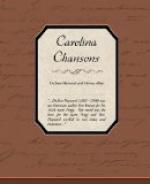St. Phillip’s Church stands in the old part of the town. During the Civil War its bells were cast into cannon. For a long time its steeple was used as a lighthouse. It is the center of forgotten things.
The bells of St. Matthew’s are modern and speak of a new order, but all the bells are the voice of the town. They speak for her silences, which are eloquent.
NOTE ON “THE PIRATES”
The many inlets and sheltering coves of the Carolina coasts very early made the “low country” seaboard a rendezvous for pirates and a shelter to refit, and to bury their treasure.
As early as 1565 the French from Ribault’s settlement succumbed to the temptation to plunder their rich Spanish neighbors; and in the century before the coming of the English, the lonely bays and estuaries saw strange ships from time to time. There was a pirate settlement by 1664 at Cape Fear River, where Governor Sayle did not arrive until 1670 to take formal possession for the Lords Proprietors of the colony.
The Peace of Utrecht turned many privateers into pirates, ships which had been habitually preying upon Spanish commerce since Blake’s victory at Santa Cruz in 1657, and these gentlemen of fortune were at first welcome in the Carolinas. Nearly all the coin in circulation then was at first brought by such doubtful adventurers, and they were regarded as the natural protectors of the Carolinas against their powerful enemy, the Spaniard, to the south.
Gradually, however, this cordial attitude changed. It was a small step from attacking Spanish to plundering English commerce, and with the cultivation and export of rice and indigo, the demand for a safe sea passage grew overwhelming, while the coasts continued to be ravaged. The royal government was slow to act. In 1684 we learn that “the governor will not in all probability always reside in Charles Town, which is so near the sea as to be in danger of sudden attack by pirates;” nor was this an idle thought, for the town was blockaded by pirate ships at the harbor’s mouth, and medicines and supplies demanded while citizens were held as hostages.
In 1718 Governor Spotswood of Virginia sent an expedition to North Carolina, which succeeded in surprising, capturing, and beheading the notorious “Black Beard,” who in company with one Stede Bonnet, had long ravaged the coast with impunity.
In August of the same year word was brought to Charlestown that Bonnet with his ship the Royal James was refitting in the Cape Fear River. Colonel William Rhett volunteered to attack him. With two sloops of eight guns each, the Henry and the Nymph, and about 130 men in all, he set sail, and found Bonnet at anchor in the Cape Fear River. In making the attack, and during the encounter, all three ships ran aground. The fight raged desperately all day between the Henry and the Royal James, the Nymph being unable to get off the shoal and come to the help of her companion ship. Bonnet finally surrendered and was taken prisoner to Charlestown. It is this adventure which the poem celebrates.




